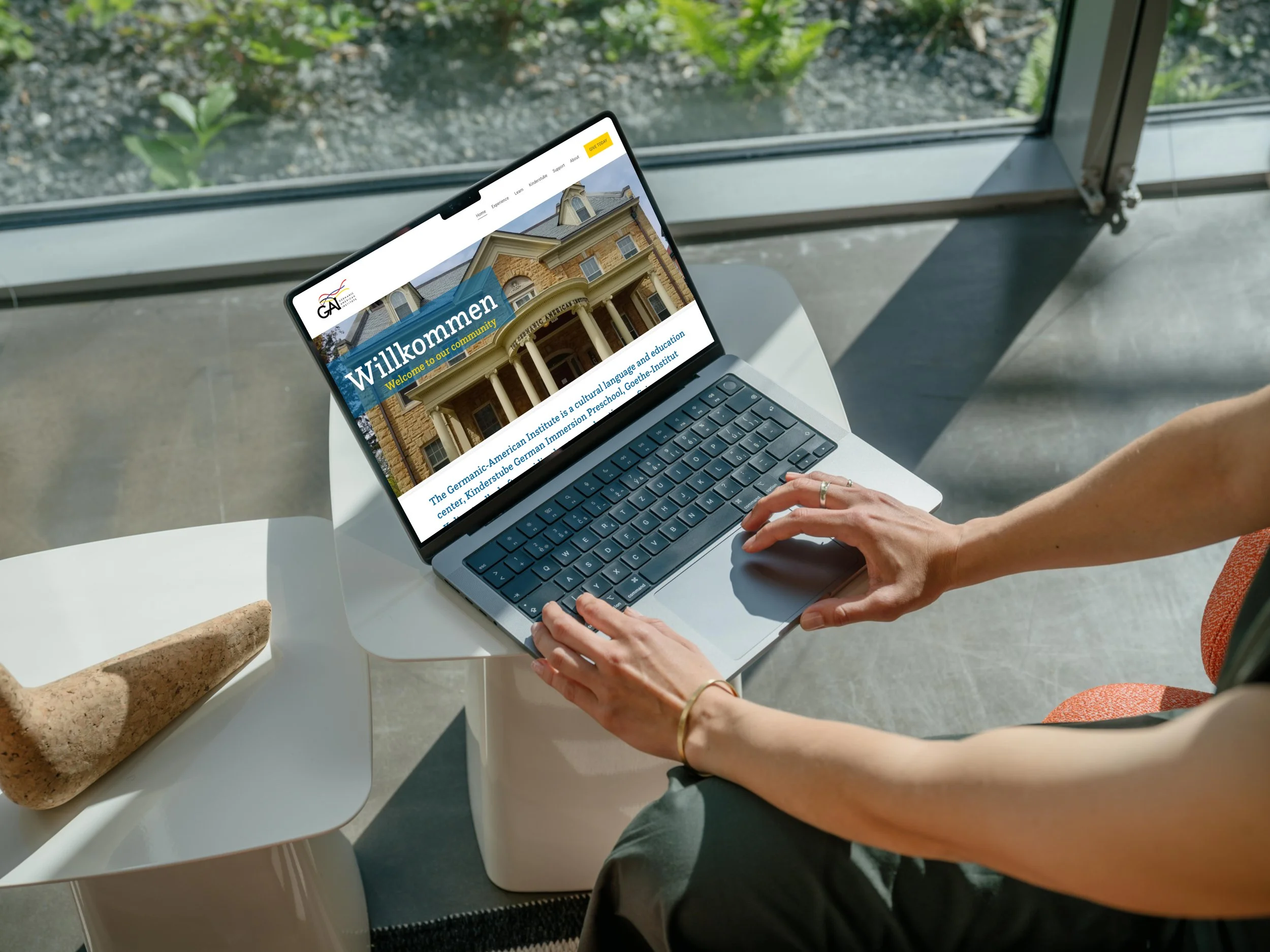GAI
Redesigned the Germanic American Institute website. Collaborated closely with the marketing manager to align design direction with the institute’s branding and goals. Designed and implemented the new website structure and layout. Conducted user research and gathered data through surveys to inform design decisions and developed engaging content showcasing language classes, calendars, events, programs, resources, preschool, support features and an about section.
My role: UX Designer and Website Creator
HCD Methods: Competitive analysis, user research, user personas, card sorting, affinity mapping, user flow analysis, low to high-fidelity wireframes, prototypes, usability testing.
Features: Mega header for streamlined navigation, interactive event calendars, informative resource sections, user-oriented program descriptions.
Tools: Squarespace, Figma, Canva, Usability Hub, Unsplash
Project Overview
Issue: The GAI faced challenges with user engagement and navigation on their previous website.
Goal: to create a more intuitive, accessible and visually appealing platform that effectively showcases the institute’s offerings, including language classes, events, education, cultural programs and resources.
Executive Summary
In collaboration with the marketing manager, I undertook a project to redesign the Germanic American Institute’s website using Squarespace. The primary focus was to improve user experience through an organized structure, enhanced navigation and engaging visuals. This redesign aimed to meet the needs of diverse users while ensuring their interactions with the site were valuable and enriching.
Project Highlights:
Developed competitive analysis, a survey with 57 participants to inform design decisions using user personas.
Enhanced user experience through card sorting with 15 participants, affinity mapping and user flow analysis.
Simplified site navigation for easier access to essential information.
Introduced a mega header that consolidates frequently accessed pages, making it easy for users to find what they need quickly.
Enhanced overall clarity of content presentation, ensuring that information is not only accessible but also intuitive to navigate.
Designed low to high-fidelity wireframes and prototypes, featuring recipe discovery, article favorites, and personalized reminders.
Conducted usability tests with x participants, iterated based on feedback and collaborated in feedback rounds with colleagues.
Research
Research goals
To identify the primary goals and objectives of users visiting the website.
To gather insights into what users seek most from the institute’s online presence.
To analyze pain points and challenges faced by users when navigating the existing website.
To evaluate the effectiveness of the current website layout and content in meeting user needs.
To conduct usability testing and gather feedback on navigation, content, presentation and overall user flow.
Competitor analysis
I chose OneRecord and FollowMyHealth
because these popular apps help manage, store personal health records and communicate with healthcare providers in one place.
Analyzed each app based on:
key objectives
overall strategy
marketing advantages
SWOT analysis
UX competitive analysis
Conducted a competitor analysis in order to gain more insights into the current market and user expectations, helping me spot opportunities for my app.
Conclusion
Although OneRecord and FollowMyHealth offer robust platforms for storing medical information, they fall short in providing comprehensive wellness resources, giving the opportunity for others to offer a more holistic health management experience.
Survey
Created a user survey because I wanted a way to reach a broad audience. I used Google forms and shared on my social media and via email.
17 people participated
Target audience: health conscious individuals, 18+
Combination of multiple-choice questions and open-ended responses (see example below)
Survey Insights:
Major challenges: balancing work and personal life.
Helpful techniques to manage health: regular physical activities & healthy eating.
Goals: Form habits, improve fitness and mental health, reduce irritability, tips/tricks for time management and achieve goals, better organization, better quality of life, focus on the moment, weight management, tools for better mental health such as stress and anxiety, goals tracking, consistency and happiness.
Desired features: Personalized goal-setting and goal tracking, workout routines, recipes, stress management techniques, games, reminders, mood tracking, health and wellness articles, integration with wearables devices, sleep tracking and recommendations.
Interview
Conducted 3 user interviews in order to observe behaviors and facial expressions, gaining deeper insight into the emotions and experiences of people.
Interview script in order to give people a quick overview of the purpose of the interview.
11 open-ended questions focused mainly to better understand characteristics, behaviors and motivations of potential users. Identify needs, pain points and challenges, what kind of support do users seek, and what they hope to achieve in a health and wellness app.
Research Analysis
By asking WHAT? HOW? & WHY?
I gained access to insights into users’ needs, motivations and challenges.
Affinity Mapping
Created an affinity map in order to synthesize my research data, categorize user feedback, identify patterns and highlight key insights.
Key Insights
Users have a deep concern for their physical and mental health.
They seek to take control and be proactive in managing their overall wellness.
They desire assistance with organization, categorization, reminders and progress tracking.
Their goal is to achieve a balanced life and become their best selves through improved eating habits, health education, stress management, meditation and continuous self-improvement.
User Personas
Created 3 user personas to better understand and address the diverse needs and behaviors of Vita Sanus' potential users in order to ensure it meets their health and wellness goals.
These personas helped me to understand the target audience in a better way and make sure I could design with a user-centric approach.
These 3 personas reflect some of the main target users and their expectations. This allowed me to effectively design towards meeting their needs, and providing a user experience that meets their expectations.












